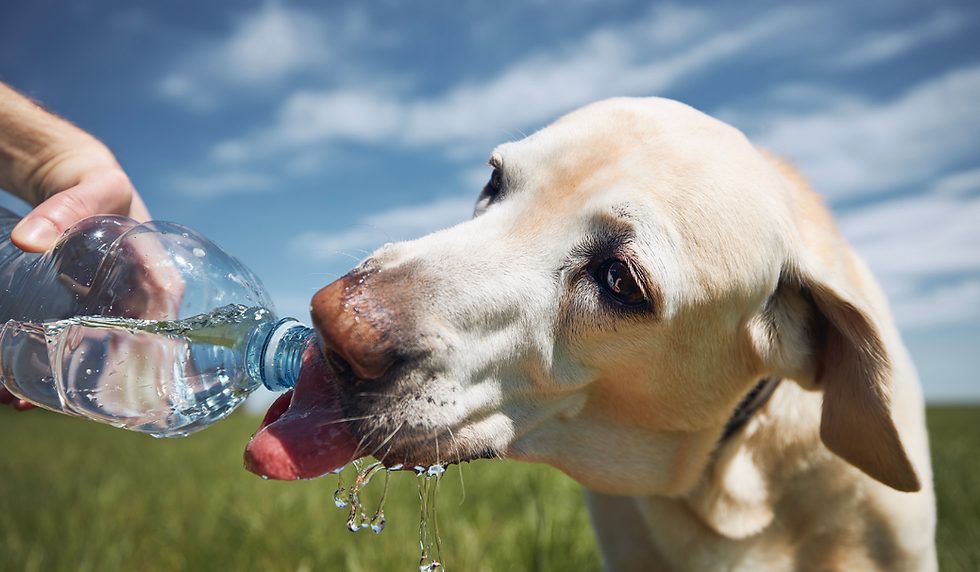Beating the Heat—Safeguarding Your Pets from Heatstroke
- Practice manager
- Jan 26, 2024
- 5 min read

As temperatures soar and the summer sun blazes, our beloved pets face the risk of heatstroke, a potentially life-threatening condition caused by elevated body temperatures. Heatstroke, also known as hyperthermia, occurs when an animal's body temperature rises above the normal range and overwhelms their natural cooling mechanisms. Unlike humans, dogs and cats primarily dissipate heat through panting, making them more susceptible to overheating.
Many pet owners may underestimate the risks associated with high temperatures, assuming their pets can endure the heat as well as they can. However, pets, especially certain breeds and those with pre-existing health conditions, are more vulnerable to heat-related illnesses.
Causes of Heatstroke
High Temperatures - The most apparent factor contributing to heatstroke in pets is soaring temperatures. When the mercury rises, pets struggle to regulate their body temperature effectively, particularly if they are exposed to direct sunlight for extended periods. As they lack the ability to sweat like humans, relying on panting and limited sweating through their paw pads, excessive heat can quickly lead to overheating.
Humidity Levels - Humidity exacerbates the challenges of cooling for pets. When the air is saturated with moisture, evaporative cooling—the process through which panting becomes less effective—is hindered. This makes it even more challenging for pets to release excess heat, increasing the risk of heatstroke.
Lack of Shade - Access to shade is paramount for preventing heatstroke. Without a shaded area to retreat to, pets are left exposed to the full intensity of the sun, intensifying the heat they experience. Providing ample shaded spots in outdoor spaces is crucial to allow pets a reprieve from the sun's unrelenting rays.
Restrained Movement - Pets that are restrained or confined in small, enclosed spaces during hot weather are at a heightened risk of heatstroke. Limited movement impedes their ability to find cooler spots, and the lack of airflow can contribute to a rapid increase in body temperature. Whether in a car, crate or tethered in a yard, restricted movement can be perilous in high temperatures.
Common Risk Factors
Breed Susceptibility - Certain breeds are more prone to heat-related issues. Brachycephalic breeds, characterised by short noses and flat faces, such as Bulldogs, Pugs, and Persian cats, struggle more with temperature regulation due to their unique respiratory anatomy. It's crucial for owners of these breeds to be extra vigilant during hot weather.
Age Considerations - Puppies and kittens, as well as senior pets, are more susceptible to heatstroke. Young animals may not have fully developed cooling mechanisms, while older pets may have diminished abilities to cope with extreme temperatures. Special attention should be given to these age groups during hot weather.
Health Conditions - Underlying health conditions, such as obesity, respiratory problems or heart disease, can compromise a pet's ability to handle heat stress. Medications or illnesses affecting the normal functioning of their body systems can make them more vulnerable to heat-related complications. Understanding your pet's health status is crucial in assessing their risk and taking appropriate precautions.
Recognising the Signs of Heatstroke
Behavioural Changes
Restlessness - One of the early indicators of heatstroke in pets is restlessness. If your normally calm and composed pet suddenly becomes agitated, paces around, or seems unable to settle, it could be a sign of distress.
Excessive Panting - While panting is a normal cooling mechanism for pets, excessive panting can be a red flag. If your pet is panting excessively, with rapid and shallow breaths, it indicates that their body is working overtime to regulate their temperature. Pay close attention, especially if the panting persists even when they are at rest.
Agitation - Agitation, manifested through pacing, whining, or an inability to sit still, is a clear indication that your pet may be uncomfortable or in distress. Pets in the early stages of heatstroke may exhibit signs of anxiety or nervousness as their body temperature begins to rise beyond a safe threshold.
Physical Symptoms

Rapid Heartbeat - A heightened heart rate is a physical manifestation of the stress placed on a pet's cardiovascular system during heatstroke. You can check your pet's pulse by feeling for the heartbeat in the chest behind the elbow. A significantly elevated heart rate, especially in conjunction with other symptoms, warrants immediate attention.
Excessive Drooling - Excessive drooling, more than the usual amount observed in pets, can indicate heat-induced stress. As they struggle to cool down, pets may produce an excessive amount of saliva. Wet or damp fur around the mouth and neck is another observable sign of increased drooling.
Vomiting and Diarrhoea - Heatstroke can lead to gastrointestinal distress, resulting in vomiting and diarrhoea. The body's attempt to cool down can trigger nausea and digestive issues. If you notice your pet exhibiting these symptoms, it is crucial to act promptly, as dehydration and electrolyte imbalances can escalate rapidly.
If you observe any of these symptoms in your pet, especially during hot weather, it's imperative to take immediate steps to cool them down and seek veterinary assistance. Early intervention can significantly improve the chances of a positive outcome.
Heatstroke Prevention

Providing Shade - Ensuring that your pets have access to shade is fundamental in preventing heatstroke. Whether they spend time in the backyard or accompany you on outdoor adventures, having shaded areas allows them to take a break from direct sunlight and helps regulate their body temperature. Set up shelters, use umbrellas, or create natural shaded spots to provide relief during the hottest parts of the day.
Adequate Hydration - Hydration is a key factor in preventing heatstroke. Always make fresh and cool water available to your pets, both indoors and outdoors. During hot weather, they may need more water than usual to stay properly hydrated. Consider adding ice cubes to their water bowls or using pet-friendly water fountains to encourage regular drinking.
Planning Walks During Cooler Times - Plan walks and exercise sessions during the cooler parts of the day, such as early mornings or evenings. Avoid strenuous activities during the peak heat hours to minimise the risk of overheating.
Protecting Paws from Hot Surfaces - Hot surfaces, such as asphalt and concrete, can reach scorching temperatures during summer. Protect your pet's paws by walking them on grass or using pet booties. If the pavement is too hot for your bare feet, it's too hot for your pet's paws as well. Regularly check the temperature of surfaces to ensure they are safe for your pet.
Never Leaving Pets in a Parked Car - Leaving pets in parked cars, even for a short period, can lead to rapid overheating and is a common cause of heatstroke. The temperature inside a parked car can soar to dangerous levels within minutes, even with the windows cracked. Never leave your pet unattended in a vehicle, and if you must travel with them, ensure they have proper ventilation and never leave them alone.
Emergency Response
Steps to take if you suspect heatstroke:
Moving Your Pet to a Cooler Area - If you suspect your pet is experiencing heatstroke, the first and most immediate action is to move them to a cooler area. Get them out of direct sunlight and into a shaded or air-conditioned space. This rapid change in environment can help lower their body temperature and mitigate further heat-related stress.
Providing Water and Wet Towels - Hydration is crucial in managing heatstroke. Offer your pet small sips of cool water, allowing them to drink at their own pace. Avoid using ice-cold water, as this can cause shock. Additionally, wetting your pet's fur with cool (not cold) water can aid in the cooling process. Focus on areas with major blood vessels, such as the neck, groin and armpits. Applying wet towels or using a cool compress can be effective in lowering their body temperature.
Seeking Immediate Veterinary Attention - Heatstroke is a medical emergency, and prompt veterinary care is essential. Even if your pet appears to recover with initial interventions, it's crucial to seek professional help. Internal damage and complications may not be immediately apparent. Call us or your nearest emergency animal clinic to inform them of the situation and follow their guidance. Emergency veterinary care can provide the necessary treatment, including intravenous fluids, monitoring and additional supportive measures.
By incorporating these preventive measures into your routine, you can significantly reduce the risk of heatstroke in your pets. Being proactive and attentive to their needs during hot weather is a testament to responsible pet ownership and ensures a safe and enjoyable experience for your pets this summer.


























Comments